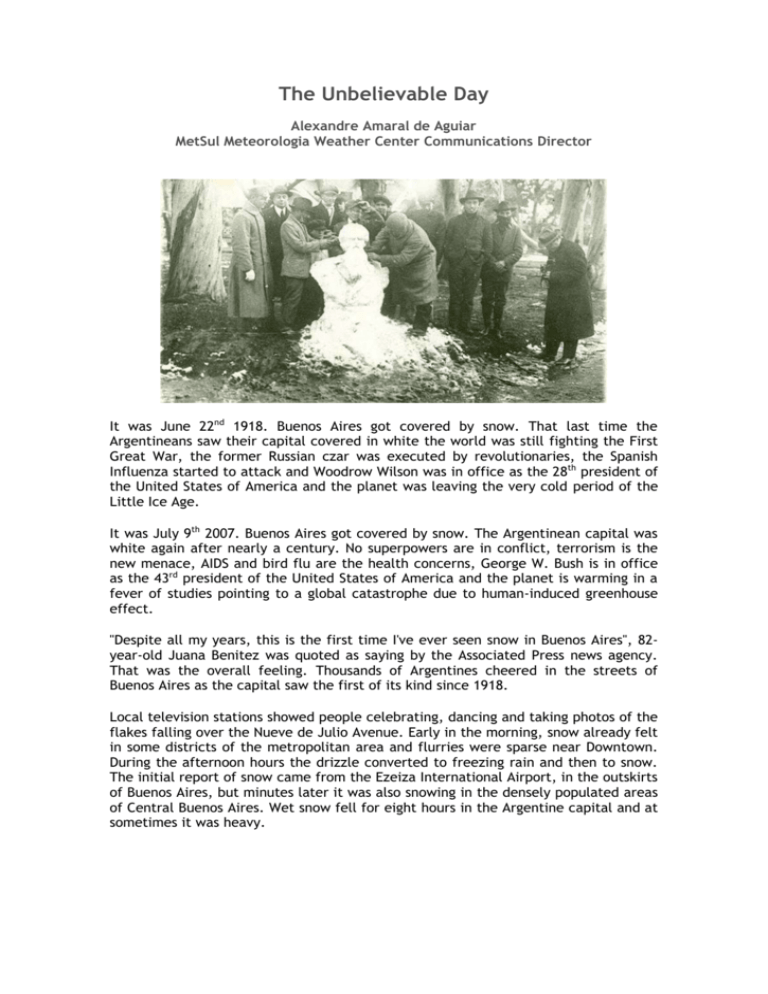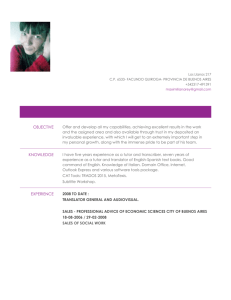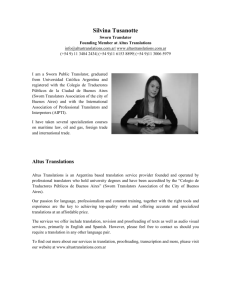here. - Icecap
advertisement

The Unbelievable Day Alexandre Amaral de Aguiar MetSul Meteorologia Weather Center Communications Director It was June 22nd 1918. Buenos Aires got covered by snow. That last time the Argentineans saw their capital covered in white the world was still fighting the First Great War, the former Russian czar was executed by revolutionaries, the Spanish Influenza started to attack and Woodrow Wilson was in office as the 28th president of the United States of America and the planet was leaving the very cold period of the Little Ice Age. It was July 9th 2007. Buenos Aires got covered by snow. The Argentinean capital was white again after nearly a century. No superpowers are in conflict, terrorism is the new menace, AIDS and bird flu are the health concerns, George W. Bush is in office as the 43rd president of the United States of America and the planet is warming in a fever of studies pointing to a global catastrophe due to human-induced greenhouse effect. "Despite all my years, this is the first time I've ever seen snow in Buenos Aires", 82year-old Juana Benitez was quoted as saying by the Associated Press news agency. That was the overall feeling. Thousands of Argentines cheered in the streets of Buenos Aires as the capital saw the first of its kind since 1918. Local television stations showed people celebrating, dancing and taking photos of the flakes falling over the Nueve de Julio Avenue. Early in the morning, snow already felt in some districts of the metropolitan area and flurries were sparse near Downtown. During the afternoon hours the drizzle converted to freezing rain and then to snow. The initial report of snow came from the Ezeiza International Airport, in the outskirts of Buenos Aires, but minutes later it was also snowing in the densely populated areas of Central Buenos Aires. Wet snow fell for eight hours in the Argentine capital and at sometimes it was heavy. Late in the afternoon snow became heavier and several districts of Buenos Aires were already accumulating snow in the parks and over parked cars. Another blast of heavy snow affected the city around 8 PM when the temperature was zero degrees Celsius in Ezeiza and just one degree in the Downtown area. The snow rapidly accumulated over cars and the grass. Scene of snowmen usually seen in the ski resorts of the Patagonia region were suddenly an attraction in the urban area of the largest Argentine city. Argentina's National Weather Service (Servicio Meteorologico Nacional) confirmed it was the first major snow in Buenos Aires since June 22, 1918, though sleet or freezing rain have been periodically reported in decades since. The Servicio Meteorologico Nacional decided not to issue any snow forecast. The government agency director told the media snow was so rare that the forecasters decided not to issue a warning, despite the indication of the forecast models and the warnings from the University of Buenos Aires’ Weather Service, MetSul Meteorologia in Brazil and AccuWeather’s Jim Andrews in the United States. "This is the kind of weather phenomenon that comes along every 100 years," forecaster Hector Ciappesoni told La Nacion newspaper. "It is very difficult to predict". It was not a difficult event to predict, but an event difficult to believe until the flakes started to whiten the city. The frigid weather was not confined to Buenos Aires. It snowed for the first time in 35 years in some cities of the northern Buenos Aires Province. It snowed for the first time in history in some towns of the Santa Fe Province. Southern Santa Fe Province experienced the snowiest day since 1973. Cordoba City the heaviest snowfall since 1975. Mendoza went trough he heaviest snowstorm in decades. Temperature fell to minus 19 degrees Celsius in Patagonia and near all-time record in Bariloche (most famous ski resort in South America). Windchill in Bariloche was record: -minus 22 degrees. Low temperature in Bahia Blanca, Southern Buenos Aires province, fell to outstanding 9 below zero Celsius. Snow also fell in northern Provinces and in Bolivia isolated the capital La Paz from the rest of the country. The snow event followed a bitterly cold month of May that saw subfreezing temperatures, the coldest in 40 years in Buenos Aires. That cold wave contributed to an energy crisis and dozens of deaths. This 2007 May figured among the coldest in recent decades also in Uruguay and Southern Brazil (GISS global temperature anomaly map for May). The huge city of Buenos Aires got warmer in recent decades. Urbanization was dramatic and the temperature followed the incredible expansion of the city along the 20th century. Nearby towns with rural stations or near the sea showed little or no warming and some presented even a cooling trend since the 80’s. The day Buenos Aires saw snow after nearly a century in the global warming era will be remembered for generations. As 1918 was remembered in the beginning of the 21st century. It will be remembered as the unbelievable day. The day some said it was impossible, but Nature proved differently. This is an exclusive report prepared by MetSul Weather Center to ICECAP




